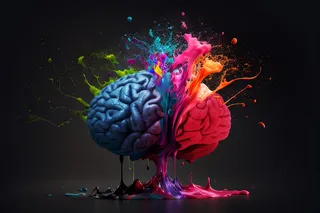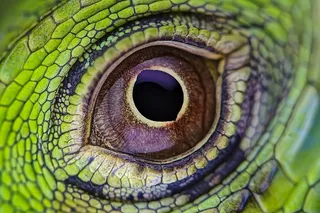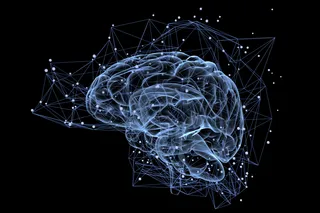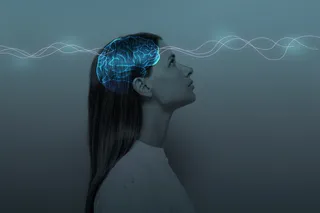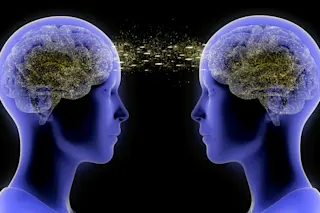Fear may not be one of the more pleasurable emotions, but it is an effective survival tool. Sheer terror efficiently propels you away from the predator that wants to eat you; anxiety, fear’s milder (if more gnawing), civilized form, chivies you into meeting the deadline set by a scary superior. In either case, the reward you get for enduring the cold sweat and the pounding heartbeat is that you live on to gather up another lunch or meet another deadline.
Unfortunately, fear sometimes floods out beyond the channels where it’s useful. Take the experience of the Gunny, as he asked to be identified: the Gunny was stationed with the Marines in Vietnam from 1969 to 1971. He is a compact, powerfully built man with a threateningly shaved head but a disconcertingly kind gaze and a gentle voice. I go into deep flashbacks, he says. It’s like I’m right there again--the sounds, the smells, the screaming. It’s almost like a blackout; the present doesn’t exist. It can be snowing and I sweat like I’m in the jungle. So debilitating did these attacks become that one day in 1987 the Gunny walked away from his Pittsburgh post office job and spent the next three years in the backcountry of Pennsylvania--emerging only when he found himself stalking hunters in the woods. Scared by this silently rising pressure of violence, he forced himself back into civilization and began treatment.
The gunny suffers from post-traumatic stress disorder, a pathological form of anxiety. The syndrome typically begins with a trauma beyond the range of normal human experience--combat, say, or a disaster like the Kobe earthquake or the World Trade Center bombing. Some people emerge unscarred by such experiences, but PTSD patients are uncontrollably and often permanently affected. Small irritants like a thunderclap can set in motion tidal waves of panic, even full-color flashbacks, during which sufferers relive horrors that may have vanished from their conscious memories.
The war in Vietnam spawned a near epidemic of PTSD. In fact, U.S. soldiers’ experiences there gave rise to what’s now regarded as the classic form of the disorder. Vets like the Gunny, who is undergoing treatment at the National Center for PTSD (a unit of the Veterans Affairs Medical Center), in West Haven, Connecticut, are far from unusual. I can numb out for hours, not thinking of anything, echoes George K., another patient at the center. But then something will remind me and take me back--the odor of a certain kind of wood burning, or even of a plant, since I live in Florida and the vegetation is a lot like Vietnam’s.
Traditional psychotherapy has had at best mixed success in treating PTSD--its tools, as many therapists will admit, are blunt and imprecise, not finely matched to the physiological mechanism of the disease. George K. and the Gunny are part of a therapy program with confessedly modest goals: getting the patients to accept their disorder as chronic and their progress as a matter of halting, reversible steps. But bizarre though the experiences of PTSD sufferers may be, and frustrating as the condition is to treat, it’s no longer as mysterious as its quasi- hallucinatory manifestations might suggest. Neurobiologists have now identified and begun to disentangle the cranial wiring that gives rise to it--opening up the possibility, they believe, of treatment based on the anatomy of the syndrome. The more visionary researchers in the field dream of drugs engineered to zero in on the cerebral mechanisms that go haywire during a PTSD attack.
The key to their hopes is an unprepossessing piece of the brain, a chickpea-size tangle of neurons called the amygdala. The term, Latin for almond, describes the structure’s shape. As with most brain structures, you’ve got two more or less symmetrical amygdalae--one on the right, another on the left, just behind your ears. Just above the ear is the temporal lobe of your brain, explains Joseph LeDoux of New York University’s Center for Neural Science. The amygdala’s on the interior underside of it.
Anatomists first encountered the amygdala centuries ago, though they hadn’t a clue as to what it did. Recently, however, amygdala research has flourished as several radically different approaches to studying the brain have come together, giving neuroscientists a sharper picture of the biology of terror. The work is in three parts. First researchers like LeDoux perform behavioral experiments: they subject test animals to fear- causing stimuli, such as a mildly unpleasant pulse of electricity, then measure the animals’ responses. Next they track those responses to particular parts of the brain. Finally they peer deep into the microscopic reaches of those structures, tracing the intricate nerve-to-nerve signaling that accompanies the reaction.
The behavioral experiments at the base of this work wouldn’t, in principle, surprise a tyro in sophomore biology. It’s been nearly a century, after all, since Ivan Petrovich Pavlov stumbled on the discovery that the brain changes itself in response to a consistently administered stimulus. When Pavlov’s assistant brought his lab dogs meat regularly, they soon began salivating every time they saw him. Somewhere in the dogs’ brains, Pavlov’s lab assistant and yumminess, however improbably, had been joined by a firm physiological bond.
Pavlov’s salivating dogs bear some relevance to human fear in general, and PTSD patients in particular, in that the reactions are a response to specific stimuli. But PTSD sufferers bolt into panic at stimuli most of us would find at most mildly startling. Psychologist Michael Davis of the Yale School of Medicine recalls one Vietnam veteran who, years into therapy for PTSD, had gotten well enough to marry: But as he was leaving the church with his new bride, a car backfired. He dove into the bushes. Now, there should have been all kinds of signals in the environment that told him everything was okay. It was 25 years later; he was in the United States, not Vietnam; he was at a church; he was wearing a white tuxedo, not battle fatigues. But when that primordial stimulus came through, he ran for cover. People with anxiety problems just don’t respond adequately to safety signals.
Approximating an experience like this with lab animals is tricky. If you give a rat a mild shock and accompany the experience with a flash of light, the rat will soon exhibit a startle response--usually by freezing in place--when it sees the light alone. But suppose you want to equate the rat’s learned behavior with a human’s experience of acquired fear. How do you know that a rat is feeling fear just because you see it freeze?
Davis, among others, has addressed this difficulty by devising some ingenious experimental techniques. One is called, unmellifluously, the fear-potentiated startle paradigm. First you give the rat a series of shocks to the foot, each accompanied by a flash of light; the rat learns to freeze when it sees the light. Next you expose it to a burst of white noise, which predictably makes it jump. Then you accompany the white noise with the light flash, and now the rat jumps higher than it does when it hears the noise alone. Which proves two things. First, the light in itself is a neutral stimulus (because it doesn’t make the rat leap). Second, the light--through its association with the shocks--has acquired the ability to intensify the rat’s fear reaction to other startling events, such as a sharp noise. The light triggers a learned fear rather than causing the fear directly.
It works in humans too--only with us you assess startle by measuring how strongly we blink our eyes. In one experiment, Davis and his colleagues found that eye-blink reflexes intensify if subjects are warned to expect a shock from an electrode fastened to their wrists--demonstrating that a piece of information not painful in itself can tap a reservoir of learned fear in the brain.
Where in the brain is this linkage between stimuli forged? By the 1950s and 1960s the amygdala had already started to emerge as a suspiciously significant site. Researchers found that when a monkey’s amygdala was damaged, the animal became tamer, less responsive to threats, and generally less fearful. A bit later, using electrical probes in living animals, they showed that in experiences of remembered fear the amygdala, figuratively, lights up like a Christmas display. If we stimulate the amygdala electrically with a very low current, Davis says, we can facilitate startle: it’s just like a natural fear situation. Conversely, Davis and others had learned by the mid-1980s that fear-potentiated startle disappears if you remove a key part of an animal’s amygdala. Show a lab rat its inaugural cat and its blood pressure and heart rate shoot up, apparently by instinct. But take out its amygdala and the rat blithely ignores predators.
For obvious reasons, this kind of experiment can’t be done on humans, and suggestive as the animal work is, neurologists have been hesitant to make the leap. But late last year a group of researchers from the University of Iowa College of Medicine offered persuasive evidence that the phenomenon does indeed extend to people. Their patient, S. M., suffers from a disease that destroyed her right and left amygdalae--a rare phenomenon. Her condition hasn’t damaged her memory or emotions, except in the case of fear. She can’t recognize--can’t even imitate--a fearful human facial expression.
Recent technological advances have allowed neuroscientists to begin more detailed brain mapping. Researchers are delving into minute nerve circuits that course through the amygdala and link it with other parts of the brain. When I started working in this field, it was very, very difficult to figure out how certain areas of the brain connect to other areas, Davis remarks. But one of the wonderful things that have happened in the last 15 years is that we’ve begun to be able to track the connections. Such work became possible thanks to advances in microbiology, the field that in the last decade or so has uncovered so much about the innards of living cells, including nerves.
The mapping began with axons--the long, snaky parts of nerve cells, which connect the cells to one another. Axons, Davis explains, are full of distinctive proteins that shuttle up and down their length, bearing biochemical messages. People found you could inject a fluorescent dye that these proteins would take up, then transport all the way back along the axon to the cell body. Davis and his colleagues introduced just such a dye into the relay of nerves that produce a startle response in rats. It led straight back to the amygdala, he says.
By patiently applying such techniques, Davis and others have begun to assemble a vividly colored road map of neurons to and from the amygdala, and they’ve found that the tentacles reach in some surprising directions. A tangle of input nerves enters the amygdala in two regions called the basal and lateral nuclei. Another important knot of nerves courses outward from an area called the central nucleus and leads ultimately to all the end points that administer the visible business of fear--the nerves and muscles that make you jump out of your chair when a car backfires, raise your blood pressure, and speed your heartbeat.
The researchers have also found that although information can flow into the amygdala from the cortex--the section of the brain traditionally associated with higher mental functions like reasoning--it can arrive there from more primitive regions as well, areas that in humans, at least, seem independent of consciousness. You can seriously damage the part of an animal’s cortex that interprets auditory signals, yet the amygdala, receiving and processing signals that bypass the cortex, will still teach the animal fear.
This connection begins to hint at how, if you’re pathologically anxious, you can undergo fission at the sound of a thunderclap, even though your conscious mind tells you you’re safe at home in Des Moines by your VCR. A trauma sensitizes the amygdala, imprinting it with a potent yet unconscious memory of fear, training it to jerk all the neural cords of terror every time your five senses transmit a stimulus that, no matter how innocently, echoes the primal episode. The thunderclap, let us say, is like a gunshot. The gunshot was experienced a quarter century ago in a field in Southeast Asia and is entwined with images of death. Once these pathways are glued together, LeDoux says, the link is there. A stimulus, like the sound of guns, gets tied up with the horror of seeing the bodies.
Now, unfortunately, when the innocent sound of thunder reaches your ear, a signal bypasses the cortex, traveling from your ear into the amygdala, where the traumatic combat experience has permanently linked it to an outbound circuit that activates all the dolor of panic. Any deliberate, reasoned attempts to deal with the remembered trauma are subverted by neural circuits completely beyond your conscious control.
But how is it that other, associated stimuli also get tied up with the same irrational response? Say you saw your buddy blown up in front of you in the desert in Kuwait, Davis explains, and say you were in deep sand at the time. Now every time you see sand on the beach, it re- creates this fear. That’s the conditioning process--sand paired with an awful event.
We can guess what’s happening on the cell-to-cell level. The key players here are neurotransmitters--chemicals that relay information by squirting out from the axon of one cell, crossing the synapse (the minute gap between nerves), and activating a chemical receptor on the next cell in line. Perhaps the most widely known neurotransmitter is serotonin, and it owes its current celebrity to its tendency to be affected by Prozac, the supercelebrity of antidepressants. But in the amygdala another neurotransmitter, called glutamate, appears to dominate.
When you zoom down to the microscopic world of the nerve cells, the operation of glutamate becomes very complicated indeed. But while neurobiologists are quick to point out that they can’t yet show in minute detail what goes on during a PTSD flashback, they can speculate plausibly about how glutamate transmission might lay down a permanent trace through the brain that--in PTSD--would repeatedly allow an inherently innocuous noise like a car backfiring to provoke an uncontrollable onslaught of panic.
Glutamate transmission can work in two ways, each involving a different receptor on the tail end of the nerve cell that receives a signal. When activated, one of these--called the AMPA receptor--allows a transient impulse to speed through the system from point A to point B. Like the wake of a rowboat, all vestiges of the signal vanish almost as soon as the impulse has passed. For PTSD, though, you need permanent learning. The glutamate system might manage that too, by means of another receptor, this one called NMDA. When activated, the NMDA initiates a series of complicated biochemical changes inside the cell that allow learning to take place, laying down a permanent trace, like the imprint of a mountain bike’s tire along a dirt trail. Activating the NMDA receptor makes it permanently easier for signals to leap across the synapse, just as the bike’s tire track smooths the route for later cyclists, as if inviting more and more of them to follow it.
Now, normally the NMDA receptor is blocked; it won’t engage unless one of several things happens first. But, fascinatingly, one of the things that can liberate it is an activated AMPA receptor. That offers an intriguing (though admittedly speculative) model of how PTSD conditioning might take place. Suppose a transient stimulus--let’s say it’s the crash of a howitzer firing in battle--activates an AMPA receptor in the amygdala. That would unblock the cell’s NMDA receptor, allowing a second stimulus-- say, body parts flying--to imprint an essentially indelible trajectory from the senses into the amygdala and out again.
LeDoux cautions that research hasn’t yet reached the point at which we can make a complete voyage from this microscopic nerve world to a full-fledged human memory, which involves thousands of neurons signaling in complex patterns in many parts of the brain. Still, the glutamate system can give us a tantalizing glimpse.
What’s important here is that it may not be just the sound of the explosion that gets linked to the fearful response. Thanks to the first signal’s success in unlocking the NMDA receptor, other signals arriving at the same time, carrying information about the look of the sand, say, or the heat of the desert wind, are joined by glutamate to the same fearful response. Decades after the initial event, a neutral stimulus like the sight of a sandy beach may follow a glutamate-lit path that leads to terror.
The message, then, for some researchers is clear: alter the biochemistry of the amygdala and you change, maybe drastically, the experience of fear.
Sadly, that step won’t be easy. For one thing, a drug that safely affects glutamate transmission has yet to be found. For another, the amygdala itself is far from well understood. The brain is fantastically complicated, Davis concedes, just like the immune system. The amygdala sends a tangle of pathways in and out of the brain’s other parts, and there’s strong evidence that it’s involved in many phenomena beyond fear and other emotions. It’s been convincingly identified as a modulator of social behavior, and it may also be implicated in schizophrenia, epilepsy, and Alzheimer’s disease. Nevertheless, despite such daunting complexity, the progress researchers have made so far has emboldened many to hope for designer drugs to block the episodes of uncontrollable stress that mark conditions like PTSD.
Of course, tempting though the prospect might be, nobody wants to get rid of fear altogether. You have to be anxious enough to meet your deadline, Davis notes. So you don’t want to turn off your amygdala totally. Still, patients like the vets at West Haven’s National Center for PTSD, who suffer surges of unendurable stress, need and deserve something to keep their terror at bay. No such drug has yet appeared: that’s the disappointing news. But as the amygdala gives up more and more of its secrets, it may ultimately grant inventive pharmacologists an opening to block fear in its most nightmarish--and least useful--forms.



